
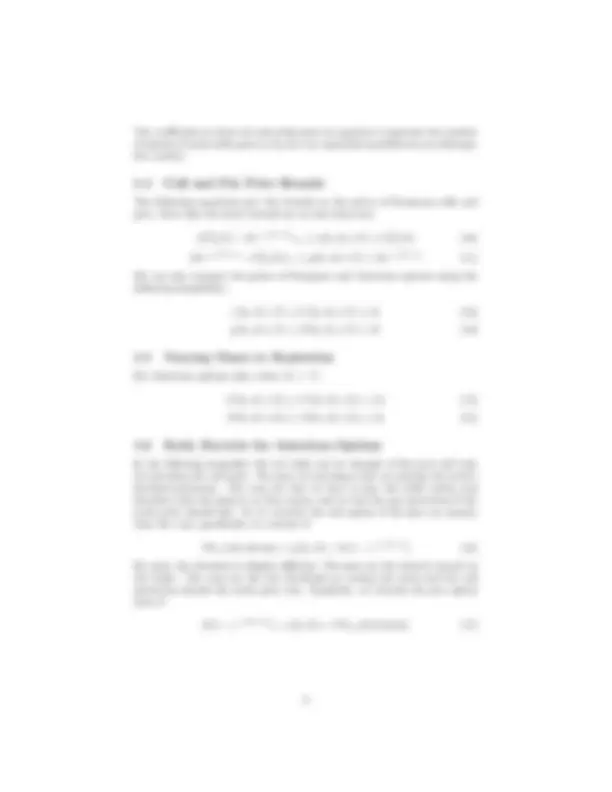
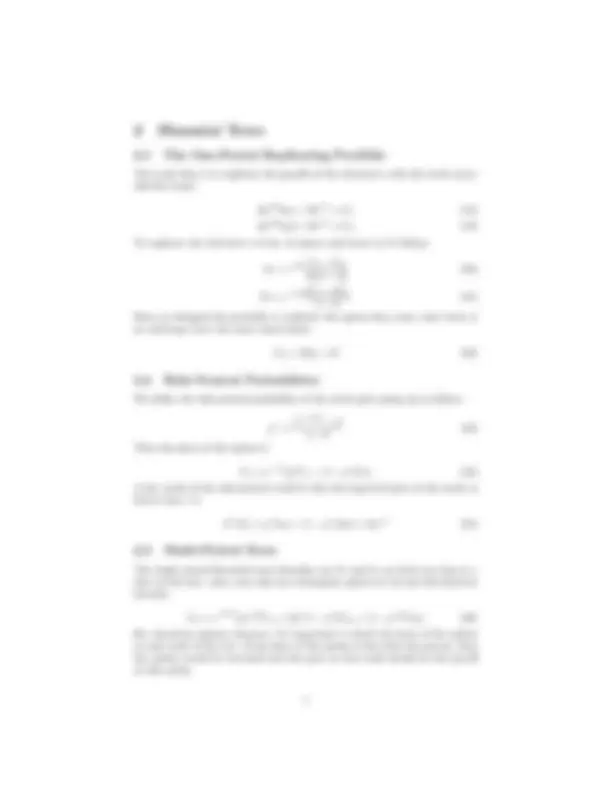
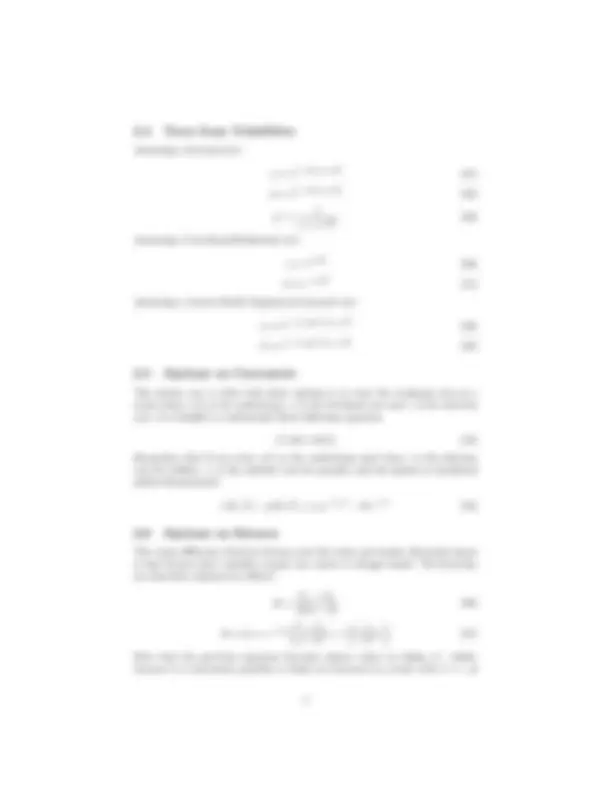
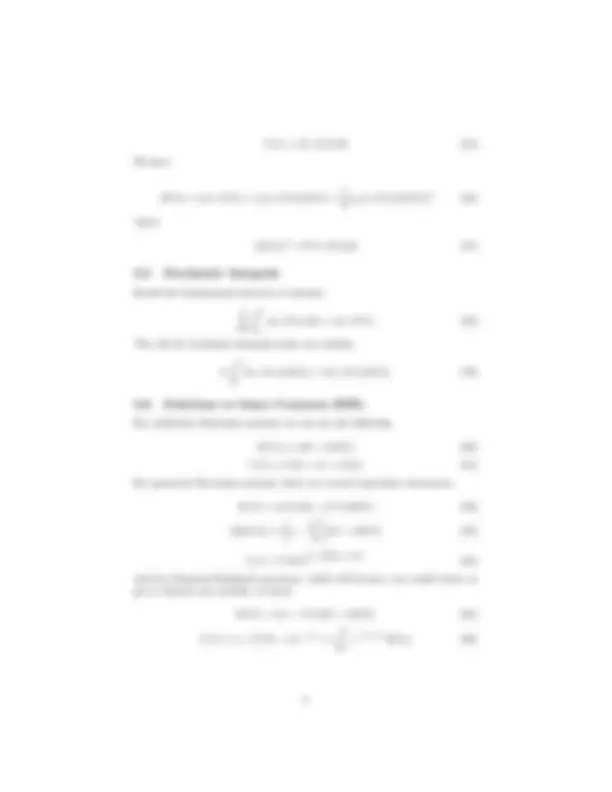
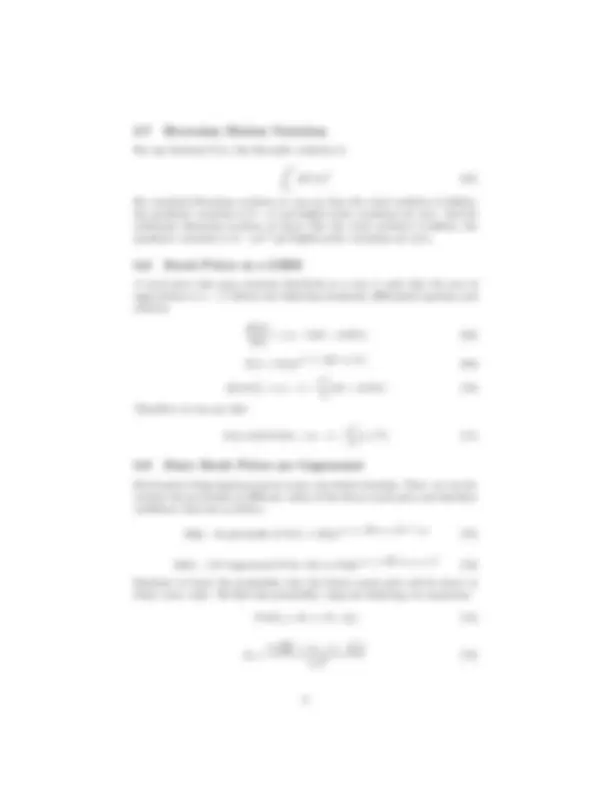
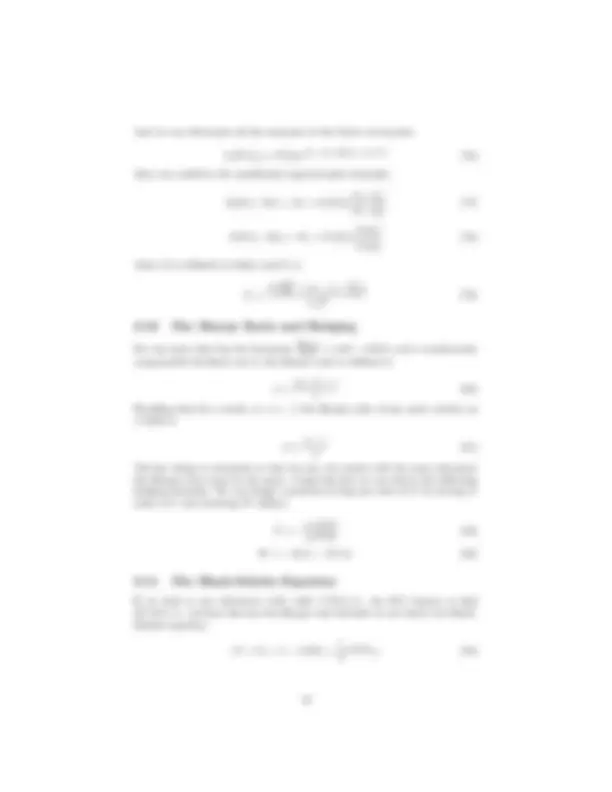
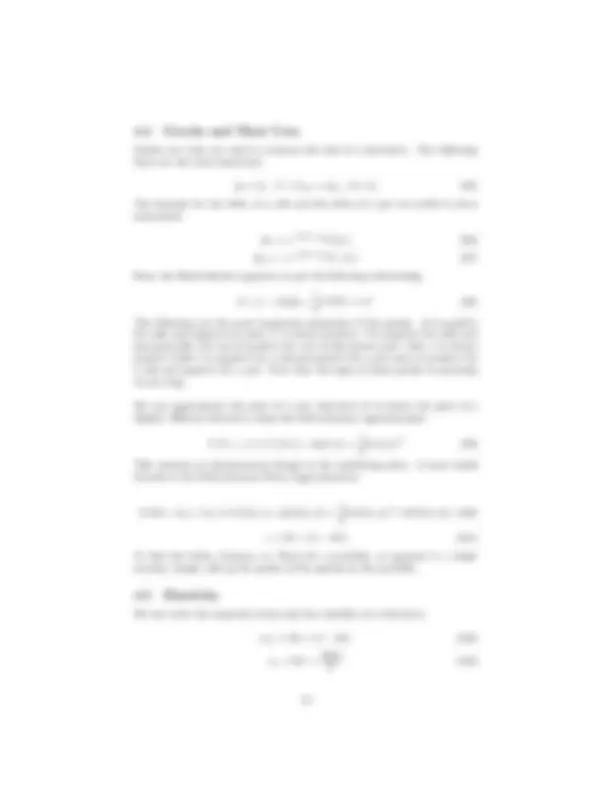
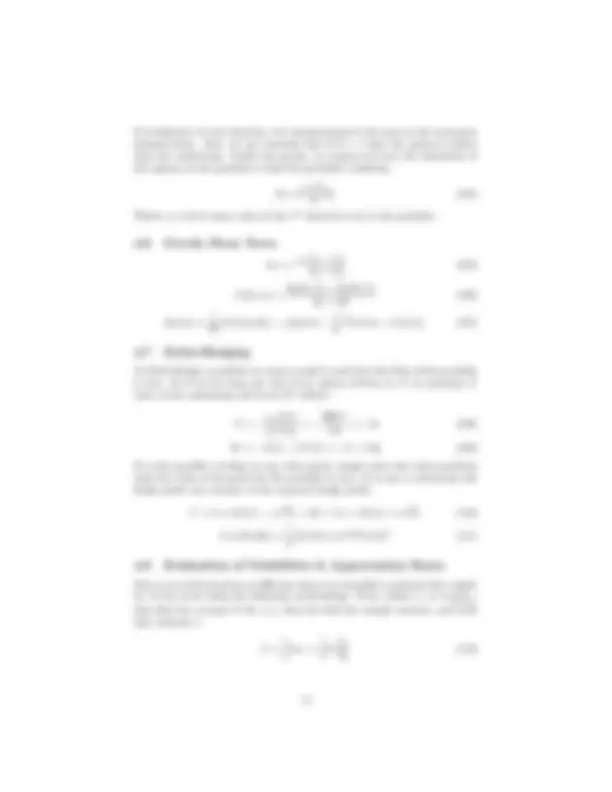
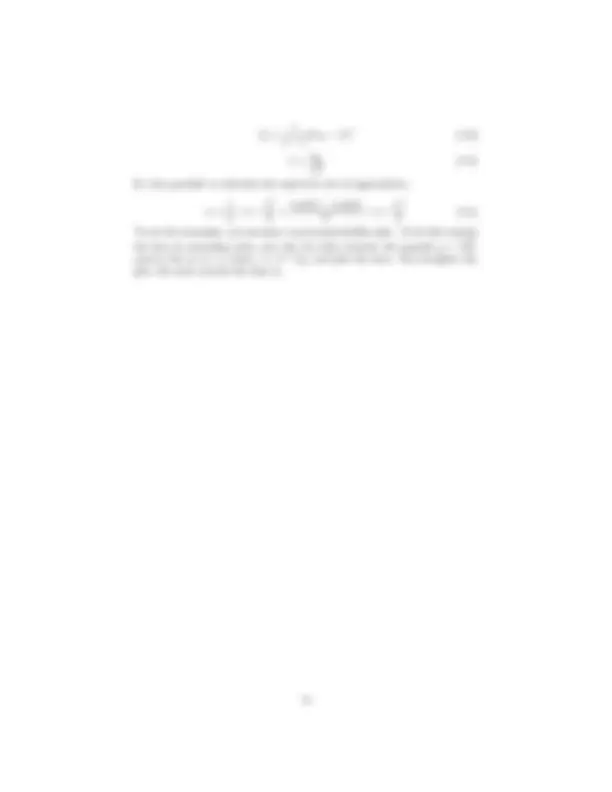

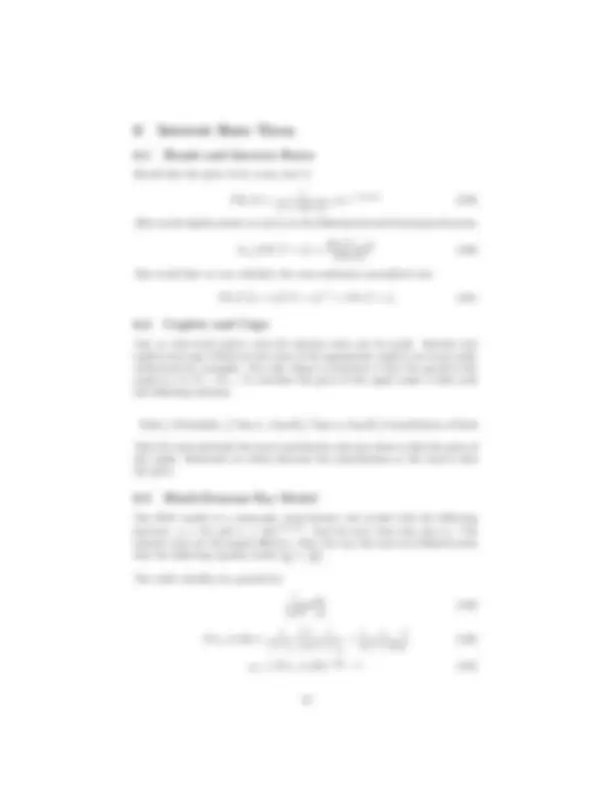
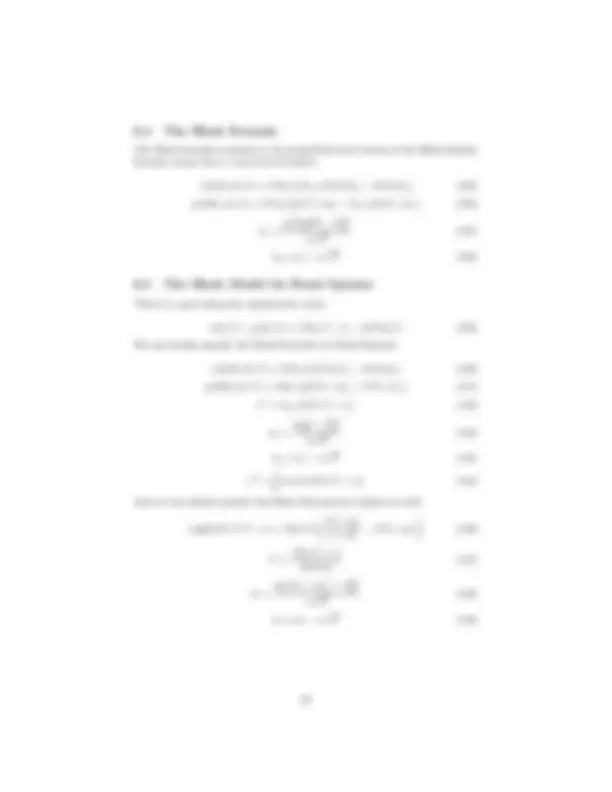
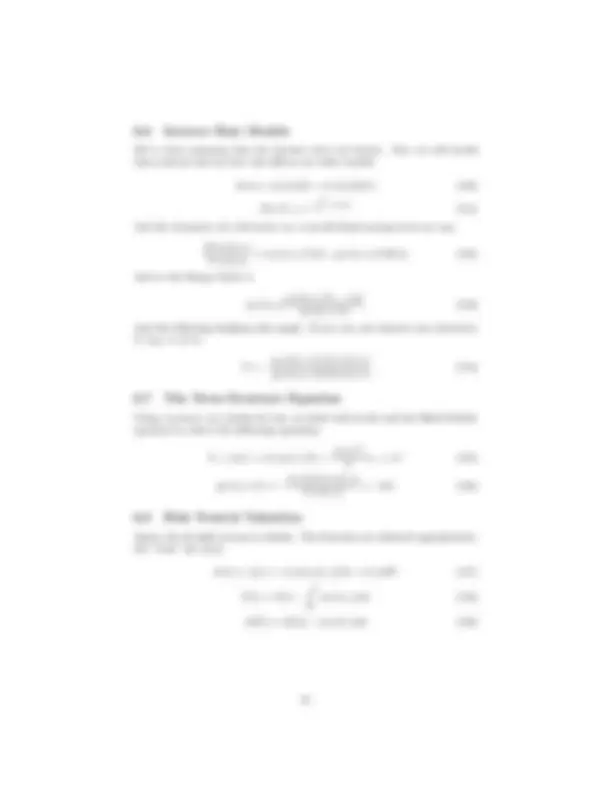
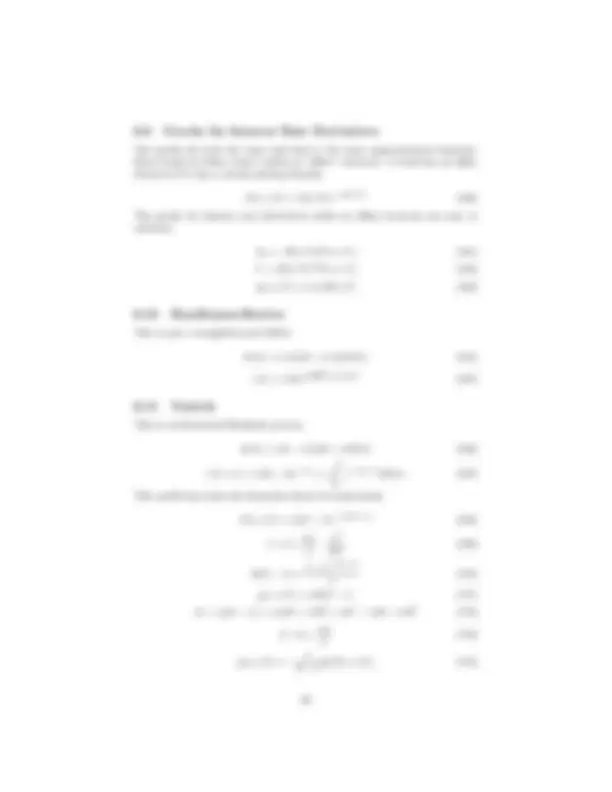



Study with the several resources on Docsity

Earn points by helping other students or get them with a premium plan


Prepare for your exams
Study with the several resources on Docsity

Earn points to download
Earn points by helping other students or get them with a premium plan
Community
Ask the community for help and clear up your study doubts
Discover the best universities in your country according to Docsity users
Free resources
Download our free guides on studying techniques, anxiety management strategies, and thesis advice from Docsity tutors
This document is meant to be used solely as a Financial Economics formula sheet
Typology: Lecture notes
1 / 23

This page cannot be seen from the preview
Don't miss anything!
















Abstract This document is meant to be used solely as a formula sheet. It con- tains very little in the way of explanation and is not meant to be used as a substitute for a financial economics text. It is aimed specifically at those students preparing for exam MFE offered by the Society of Actuar- ies, but it should be of some use to everyone studying financial economics. It covers the important formulas and methods used in put-call parity, op- tion pricing using binomial trees, Brownian motions, stochastic calculus, stock price dynamics, the Sharpe ratio, the Black-Scholes equation, the Black-Scholes formula, option greeks, risk management techniques, esti- mations of volatilities and rates of appreciation, exotic options (asian, barrier, compound, gap, and exchange), simulation, interest rate trees, the Black model, and several interest rate models (Rendleman-Bartter, Vasicek, and Cox-Ingersoll-Ross)
A forward contract is an agreement in which the buyer agrees at time t to pay the seller at time T and receive the asset at time T.
Ft,T (S) = Ster(T^ −t)^ = Ster(T^ −t)^ − F Vt,T (Dividends) = Ste(r−δ)(T^ −t)^ (1)
A prepaid forward contract is an agreement in which the buyer agrees at time t to pay the seller at time t and receive the asset at time T.
F (^) t,TP (S) = St or St − P Vt,T (Dividends) or Ste−δ(T^ −t)^ (2)
Call options give the owner the right, but not the obligation, to buy an asset at some time in the future for a predetermined strike price. Put options give the owner the right to sell. The price of calls and puts is compared in the following put-call parity formula for European options.
c(St, K, t, T ) − p(St, K, t, T ) = F (^) t,TP (S) − Ke−r(T^ −t)^ (3)
For European calls and puts, with strike prices K 1 and K 2 where K 1 < K 2 , we know the following
0 ≤ c(K 1 ) − c(K 2 ) ≤ (K 2 − K 1 )e−rT^ (4) 0 ≤ p(K 2 ) − p(K 1 ) ≤ (K 2 − K 1 )e−rT^ (5)
For American options, we cannot be so strict. Delete the discount factor on the (K 2 − K 1 ) term and then you’re okay. Another important result arises for three different options with strike prices K 1 < K 2 < K (^3)
c(K 1 ) − c(K 2 ) K 2 − K 1
c(K 2 ) − c(K 3 ) K 3 − K 2
p(K 2 ) − p(K 1 ) K 2 − K 1
p(K 3 ) − p(K 2 ) K 3 − K 2
Exam MFE loves arbitrage questions. An important formula for determining arbitrage opportunities comes from the following equations.
K 2 = λK 1 + (1 − λ)K 3 (8)
λ =
The main idea is to replicate the payoffs of the derivative with the stock and a risk-free bond.
∆eδhS 0 u + Berh^ = Cu (18) ∆eδhS 0 d + Berh^ = Cd (19)
To replicate the derivative we buy ∆ shares and invest in B dollars.
∆ = e−δh^
Cu − Cd S 0 (u − d)
B = e−rh^ uCd − dCu u − d
Since we designed the portfolio to replicate the option they must, since there is no arbitrage, have the same time-0 price.
C 0 = ∆S 0 + B (22)
We define the risk-neutral probability of the stock price going up as follows
p∗^ =
e(r−δ)h^ − d u − d
Then the price of the option is
C 0 = e−rh[p∗Cu − (1 − p∗)Cd] (24)
A key result of the risk-neutral world is that the expected price of the stock at future time t is
E∗[St] = p∗S 0 u + (1 − p∗)S 0 d = S 0 ert^ (25)
The single period binomial trees formulas can be used to go back one step at a time on the tree. Also, note that for a European option we can use this shortcut formula.
C 0 = e−^2 rh[(p∗)^2 Cuu + 2p∗(1 − p∗)Cud + (1 − p∗)^2 Cdd] (26)
For American options, however, it’s important to check the price of the option at each node of the tree. If the price of the option is less than the payout, then the option would be exercised and the price at that node should be the payoff at that point.
Assuming a forward tree
u = e(r−δ)h+σ
√ h (^) (27)
d = e(r−δ)h−σ
√ h (^) (28)
p∗^ =
1 + eσ
√ h
Assuming a Cox-Ross-Rubinstein tree
u = eσ
√ h (^) (30)
d = e−σ
√ h (^) (31)
Assuming a Jarrow-Rudd (lognormal) forward tree
u = e(r−δ−^
(^12) σ (^2) )h+σ√h (32)
d = e(r−δ−^ (^12) σ^2 )h−σ√h (33)
The easiest way to deal with these options is to treat the exchange rate as a stock where x(t) is the underlying, rf is the dividend rate and r is the risk-free rate. It is helpful to understand these following equation.
£ 1 .00 = $x(t) (34)
Remember that if you treat x(t) as the underlying asset than r is the risk-free rate for dollars, rf is the risk-free rate for pounds, and the option is considered dollar-denominated.
c(K, T ) − p(K, T ) = x 0 e−rf^ T^ − Ke−rT^ (35)
The main difference between futures and the other previously discussed assets is that futures don’t initially require any assets to change hands. The formulas are therefore adjusted as follows
Cu − Cd F 0 (u − d)
B = C 0 = e−rh
1 − d u − d Cu +
u − 1 u − d Cd
Note that the previous equation becomes clearer when we define p∗, which, because it is sometimes possible to think of a forward as a stock with δ = r, as
More specifically, this section is going to cover Brownian motions, stochastic calculus and the lognormality of stock prices and introduce the Black-Scholes equation.
The important properties of an SBM are as follows. One, Z(t)∼N(0, t). Two, {Z(t)} has independent increments. And three, {Z(t)} has stationary incre- ments such that Z(t + s) − Z(t)∼N(0, s). Also useful is the fact that given a Z(u) : 0 ≤ u ≤ t, Z(t + s)∼N(Z(t), s).
We define X(t) to be an arithmetic Brownian motion with drift coefficient μ and volatility σ if X(t) = μt + σZ(t). Note that an arithmetic Brownian motion with μ = 0 is called a driftless ABM. Finally, X(t)∼N(μt, σ^2 t).
Arithmetic Brownian motions can be zero, though, and have a mean and vari- ance that don’t depend on the level of stock making them a poor model for stock prices. To solve these problems we consider a geometric Brownian motion.
Y (t) = Y (0)eX(t)^ = Y (0)e[μt+σZ(t)]^ (50)
The following equations can be used to find the moments of a GBM. In equation 51, let U be any normal random variable.
E(ekU^ ) = ekE(U^ )+^
(^12) k (^2) V ar(U ) (51)
So specifically for geometric Brownian motions
E[Y k(t)] = Y k(0)e(kμ+^
(^12) k^2 σ^2 )t (52)
Also note, then, that Y (t) is lognormally distributed as follows
lnY (t)∼N(lnY (0) + μt, σ^2 t) (53)
First define X as a diffusion and present the following stochastic differential equation.
dX(t) = a(t, X(t))dt + b(t, X(t))dZ(t) (54)
Then for
Y (t) = f (t, X(t))dt (55)
We have
dY (t) = ft(t, X(t)) + fx(t, X(t))dX(t) +
fxx(t, X(t))[dX(t)]^2 (56)
where
[dX(t)]^2 = b^2 (t, X(t))dt (57)
Recall the fundamental theorem of calculus.
d dt
∫ (^) t
0
a(s, X(s))ds = a(t, X(t)) (58)
The rule for stochastic integrals looks very similar.
d
∫ (^) t
0
b(s, X(s))dZ(s) = b(t, X(t))dZ(t) (59)
For arithmetic Brownian motions, we can say the following
dY (t) = αdt + σdZ(t) (60) Y (t) = Y (0) + αt + σZ(t) (61)
For geometric Brownian motions, there are several equivalent statements.
dY (t) = μY (t)dt + σY (t)dZ(t) (62)
d[lnY (t)] =
μ −
σ^2 2
dt + σdZ(t) (63)
Y (t) = Y (0)e
μ− σ 22
t+σZ(t) (64)
And for Ornstein-Uhlenback processes, which will become very useful when we get to interest rate models, we know
dY (t) = λ[α − Y (t)]dt + σdZ(t) (65)
Y (t) = α + [Y (0) − α]e−λt^ + σ
∫ (^) t
0
e−λ(t−s)dZ(s) (66)
And we can determine all the moments of the future stock price.
E[Sk(t)] = Sk(0)ek(α−δ)t+^
(^12) k(k−1)(σ (^2) t) (76)
Also very useful is the conditional expected price formulas.
E[S(t) | S(t) < K] = E[S(t)]
N (− dˆ 1 ) N (− dˆ 2 )
E[S(t) | S(t) > K] = E[S(t)]
N ( dˆ 1 ) N ( dˆ 2 )
where dˆ 2 is defined as before and dˆ 1 is
dˆ 1 = ln^
S(0) K + (α^ −^ δ^ +^
σ^2 2 )t σ
t
For any asset that has the dynamics d XX((tt)) = mdt + sdZ(t) and a continuously compounded dividend rate δ, the Sharpe ratio is defined as
φ =
m + δ − r s
Recalling that for a stock, m = α − δ the Sharpe ratio of any asset written on a GBM is
φ =
α − r σ
The key thing to remember is that for any two assets with the same dynamics the Sharpe ratio must be the same. Using this fact we can derive the following hedging formulas. We can hedge a position of long one unit of X by buying N units of Y and investing W dollars.
sX X(t) sY Y (t)
W = −X(t) − N Y (t) (83)
If we look at any derivative with value V (S(t), t), use Itˆo’s lemma to find dV (S(t), t) , and put this into the Sharpe ratio formula we can derive the Black- Scholes equation.
rV = Vt + (r − δ)SVs +
σ^2 S^2 Vss (84)
Recall that to switch from the real world to the risk-neutral world we exchange α for r which leads to the following risk-neutral dynamics.
dS(t) S(t)
= (r − δ)dt + σd[ Z˜(t)] (85)
Z˜(t) = Z(t) + φt (86)
Using these risk-neutral equations we can show that
V (S(t), t) = e−r(T^ −t)E∗[V (S(T ), T ) | S(T )] (87)
This equation can be used to derive the following time-t price of a power con- tract. The payoff of a power contract is Sa(T ) at time T and the price is
F (^) t,Tp (Sa) = Sa(t)e(−r+a(r−δ)+^ (^12) a(a−1)σ^2 )(T −t) (88)
Greeks are what are used to measure the risk of a derivative. The following three are the most important.
∆ = VS , Γ = VSS = ∆S , θ = Vt (95)
The formula for the delta of a call and the delta of a put are useful to have memorized.
∆c = e−δ(T^ −t)N (d 1 ) (96) ∆p = −e−δ(T^ −t)N (−d 1 ) (97)
From the Black-Scholes equation we get the following relationship.
θ + (r − δ)S∆ +
σ^2 S^2 Γ = rV (98)
The following are the most important properties of the greeks. ∆ is positive for calls and negative for puts. Γ is always positive. θ is negative for calls and puts generally, but can be positive for very in-the-money puts. Also, ν is always positive while ψ is negative for a call and positive for a put and ρ is positive for a call and negative for a put. Note that the signs of these greeks is assuming we are long.
We can approximate the price of a new derivative if we know the price of a slightly different derivative using the Delta-Gamma approximation.
V (S + ε, t) ≈ V (S, t) + ∆(S, t)ε +
Γ(S, t)ε^2 (99)
This assumes an instantaneous change in the underlying price. A more useful formula is the Delta-Gamma-Theta Approximation.
V (S(t + h), t + h) ≈ V (S(t), t) + ∆(S(t), t)ε +
Γ(S(t), t)ε^2 + θ(S(t), t)h (100)
ε = S(t + h) − S(t) (101)
To find the Delta, Gamma, or Theta for a portfolio, as opposed to a single security, simply add up the greeks of the options in the portfolio.
We can write the expected return and the volatility of a derivative.
mV = Ωα + (1 − Ω)r (102)
sV = Ωσ = S∆σ V
Ω is defined to be the elasticity. It’s interpretation is the same as the economics interpretation. Also, we can conclude that if Ω > 1 than the option is riskier than the underlying. Unlike the greeks, we cannot just sum the elasticities of the options in the portfolio to find the portfolio’s elasticity.
wiVi P
Ωi (104)
Where wi is how many units of the ith^ derivative are in the portfolio.
∆ = e−δh^ Cu − Cd Su − Sd
Γ(Sh, h) =
∆(Su, h) − ∆(Sd, h) Su − Sd
θ(S, 0) ≈
2 h [C(Sud, 2 h) − ε∆(S, 0) −
ε^2 Γ(S, 0) − C(S, 0)] (107)
To Delta-Hedge a portfolio we want to make it such that the delta of the portfolio is zero. So if we are long one unit of an option written on X we purchase N units of the underlying and invest W dollars.
sX X(t) sY Y (t)
S∆σ V V σS
W = −X(t) − N Y (t) = −V + S∆ (109)
It is also possible to hedge on any other greek, simply enter into other positions until the value of the greek for the portfolio is zero. It is easy to determine the hedge profit and variance of the expected hedge profit.
Γ < 0 ⇒ S(t)(1 − σ
h) < S(t + h) < S(t)(1 + σ
h) (110)
V ar(Profit) =
{[Γ(S(t), t)σ^2 S^2 (t)]h}^2 (111)
Given a set of stock prices at different times, it is possible to estimate the volatil- ity of the stock using the following methodology. First, define ui as ln (^) S(Si−i1) ,
then find the average of the ui’s, then the find the sample variance, and with that estimate σ.
u¯ =
n
Σui =
n
ln
Sn S 0
Asian options are options that are based on averages in place of either the price or the strike. The average can be either an arithmetic average or a geometric average.
n
ΣS(ih) (116)
G(T ) = [ΠS(ih)]
(^1) n (117)
Then to price the option replace either the strike or the price with the appro- priate path-dependent average, calculate the payoffs, and then discount them.
Barrier options are options that become activated (knocked-in) or deactivated (knocked-out) if the stock price passes above or below a pre-determined barrier. The price of these options can either be calculated with a binomial model or with a parity equation. Knock-in option + Knock-out option = Ordinary Option.
Compound options are a pain in the butt to price and because of this the actuarial exam only asks that compound options be priced using the parity formula. Call on call + Put on call = Big Call - Ke−rt. And similarly for puts.
Gap options are options whose strike for determining if the option is exercised are different than the strike used to determine the payoff of the option. The formulas don’t need to be written as long as the original Black-Scholes formulas are understood. The strike used to calculate the value of d 1 and d 2 is the strike that determines if the option is exercised and the strike used to calculate the price of the option is the strike that determines the payoff.
Exchange options can be priced using the following parity and duality equations.
c[S(t), Q(t), K, t, T ] = Kp[S(t), Q(t),
, t, T ] (118)
p[S(t), Q(t), K, t, T ] = Kc[S(t), Q(t),
, t, T ] (119)
c[S(t), Q(t), K, t, T ] − p[S(t), Q(t), K, t, T ] = F (^) t,TP (S) − KF (^) t,TP (Q) (120)
In the above equations, S is the underlying asset and Q is the strike asset. Exchange options can also be priced using a formula very similar to the prepaid forward version of the Black-Scholes pricing equation. For example, the price of the option to get one unit of S in exchange for K units of Q can be written
F (^) t,TP (S)N (d 1 ) − KF (^) t,TP (Q)N (d 2 ) (121)
d 1 =
ln F (^) t,TP (S) KF (^) t,TP (Q) +^
1 2 σ
(^2) (T − t)
σ
T − t
d 2 = d 1 − σ
T − t (123) σ^2 = σ^2 S + σ^2 Q − 2 ρσS σQ (124)
Exchange options can be trivially applied to options that depend on a maximum or minimum of S or Q. The parity relationship is useful to know.
max[S(T ), KQ(T )] + min[S(T ), KQ(T )] = F (^) t,TP (S) + KF (^) t,TP (Q) (125)
The way we’re going to simulate stocks is by taking advantage of the lognormal- ity of stock prices. We’ll use the following method: start with iid uniform num- bers u 1 , u 2 , ..., un, calculate z’s where zi = N −^1 (u 1 ), convert these to N (μ, σ^2 ) random variables by letting r 1 = μ + σz 1.
To simulate a single stock price the following formula can be used.
S(T ) = S(0)e(α−δ−^
σ 22 )T +σ√T z (126)
Or simulate the the stock price at some time T given the stock price at a closer future time t. S(T ) = S(t)e(α−δ−^
σ 22 )(T −t)+σ[Z(T )−Z(t)] (127)
Monte-Carlo simulation goes like this: simulate stock prices, calculate the payoff of the option for each of those simulated prices, find the average payoff, and then discount the average payoff. The variance of the Monte-Carlo estimate, where gi is the ith simulated payoff, can be calculated. The variance is e−^2 rT s
2 n where
s^2 =
n − 1
Σ[g(Si) − ¯g]^2 (128)
The first method of variance reduction is stratified sampling. To do this take the iid uniform numbers and instead of taking them as is make sure the correct number go into each group. As an example, given 20 variables re-define the first five to be distributed between 0 and .25 and then next five to be distributed between .25 and .5 and so on. Then proceed as before.
Recall that the price of an s-year zero is
[1 + r(0, s)]s^
or e−r(0,s)s^ (129)
After much algebra abuse we arrive at the following forward bond price formula.
Ft,T [P (T, T + s)] = P (t, T + s) P (t, T )
Also recall that we can calculate the non-continuous annualized rate.
P (t, T )[1 + rt(T, T + s)]−s^ = P (t, T + s) (131)
Just as with stock prices, trees for interest rates can be made. Interest rate caplets and caps (which are the sums of the appropriate caplets) are most easily understood by examples. The only thing to memorize is that the payoff of the caplet is [r(t, T ) − K]+. To calculate the price of the caplet make a table with the following columns.
Path Probability Time t 1 Payoff Time t 2 Payoff Contribution of Path
Then for each path find the total contribution and sum them to find the price of the caplet. Remembe rto either discount the contributions or the total to find the price.
The BDT model is a commonly used interest rate model with the following features: rd = Rh and ru = Rhe^2 σ^1
√ h. And the next time step uses σ 2. The
interest rates are all annual effective. Also, the way the rates are defined means that the following equality holds r ruuud = r ruddd.
The yield volatility for period-3 is
1 2
h
ln
yu yd
P (ru, h, 3 h) =
1 + ru
1 + ruu
1 + rud
yu = [P (ru, h, 3 h)]−^ 21 h − 1 (134)
The Black formula is similar to the prepaid forward version of the Black-Scholes formula except that it uses forward prices.
c(S(0), K, T ) = P (0, t)[F 0 ,T (S)N (d 1 ) − KN (d 2 )] (135) p(S(0), K, T ) = P (0, t)[KN (−d 2 ) − F 0 ,T (S)N (−d 1 )] (136)
d 1 =
ln F^0 ,T K^ ( S)+ σ
(^2) T 2 σ
d 2 = d 1 − σ
There is a put-call parity equation for zeros.
c(K, T ) − p(K, T ) = P (0, T + s) − KP (0, T ) (139)
We can further specify the Black Formula for Bond Options.
c(S(0), K, T ) = P (0, t)[F )N (d 1 ) − KN (d 2 )] (140) p(S(0), K, T ) = P (0, t)[KN (−d 2 ) − F N (−d 1 )] (141) F = F 0 ,T [P (T, T + s)] (142)
d 1 =
ln (^) KF + σ
(^2) T 2 σ
d 2 = d 1 − σ
σ^2 =
V ar[lnP (T, T + s)] (145)
And we can further specify the Black Formula for Caplets as well.
caplet(K, T, T + s) = P (0, T )
N (−d 2 ) 1 + K
− F N (−d 1 )
P (0, T + s) P (0, T )
d 1 =
ln[F (1 + K)] + σ
(^2) T 2 σ
d 2 = d 1 − σ